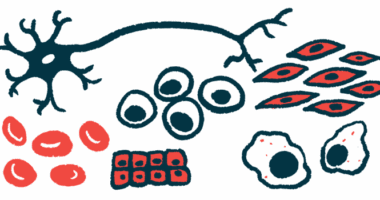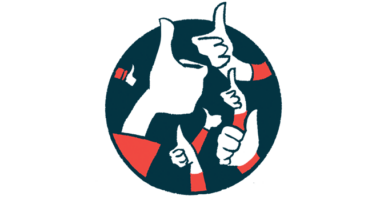Speech therapy for Pompe disease
Last updated June 13, 2025, by Susie Strachan

Pompe disease can lead to weaknesses in the muscles that control your speech, making it harder for others to understand you. Working with a speech therapist may help you improve how you speak so you can communicate more effectively.
Speech therapy for Pompe disease may include addressing issues such as weakness in speech-related muscles, breathing difficulties, and swallowing problems.
How Pompe disease affects speech
People living with Pompe disease have a buildup of a sugar molecule (glycogen) in their cells, primarily affecting their muscles. This buildup is toxic and damages cells, which results in muscle weakness and loss of muscle tone. This can impact facial muscles that are needed to communicate.
This weakening of speech-related muscles makes moving your lips and tongue harder, making certain sounds difficult to produce. Throat muscle weakness can also disrupt speech clarity, leading to slurred or unclear words.
Speech also relies on a steady flow of air from the lungs. When the muscles controlling breathing are weakened, generating enough airflow for clear speech can become more challenging, making the voice sound faint, strained, or uneven.
As Pompe disease progresses, muscle weakness tends to worsen, and speech difficulties can become more pronounced. In severe cases, you may eventually lose the ability to speak entirely.
Pompe disease in children
Children with infantile-onset Pompe disease (IOPD) may have speech that is difficult for others to understand, which can make it harder for them to connect socially.
One common issue is hypernasality, where too much air escapes through the nose while speaking, making the voice unusually nasal. Hypernasality is often accompanied by difficulty swallowing, which can increase the risk of aspiration (when something other than air gets into the airways, like food or vomit).
Infants with Pompe disease may also develop an enlarged tongue, a condition called macroglossia.
Benefits of speech therapy
Working with a speech therapist, also known as a speech-language pathologist, as part of a regular Pompe disease treatment plan can help you learn how to communicate effectively throughout the various stages of the disease.
Speech therapists can recommend strategies to support communication, such as:
- strengthening muscle function
- adapting speech techniques
- using alternative communication tools.
These strategies can enhance your ability to express yourself and interact with others, promoting greater independence in daily life.
Key speech therapy techniques
Your speech therapist’s techniques will depend on which muscles are affected and how severely. They may have you do oral motor exercises, breathing exercises, and more.
- Oral motor exercises are muscle-strengthening exercises that strengthen the tongue, lips, and jaw muscles to improve articulation.
- Breathing exercises improve respiratory support for speech by helping improve breath control and voice projection.
- Techniques such as slowing speech rate, exaggerating articulation, and incorporating pauses can also enhance speech clarity.
- In cases where verbal communication is severely affected, augmentative and alternative communication devices can help people express themselves effectively.
As children and adults with Pompe disease may have difficulty swallowing (dysphagia), speech therapy can also include modified diets and specific exercises to strengthen swallowing muscles, supporting safer eating.
Speech therapy with ventilation
Respiratory problems in Pompe disease can worsen over time. If this happens, your Pompe disease care team may recommend mechanical ventilation to assist with breathing issues.
Mechanical ventilation may involve a tracheostomy, a surgical procedure in which a breathing tube is placed directly into the trachea (windpipe).
Speaking can become more complicated when using a ventilator or breathing tube because the air doesn’t pass through the vocal cords, which are essential for producing sound.
A speech therapist can help people with a tracheostomy find ways to communicate. One method might involve briefly covering the tube’s opening with a finger to redirect air into the mouth or learning to coordinate speech with the ventilator’s airflow cycles.
Nonverbal communication
People with severe Pompe disease symptoms may eventually lose the ability to speak entirely.
When the respiratory muscles that help push air in and out of the lungs become too weak to function effectively, generating the airflow needed to pass through the vocal cords can be difficult.
The throat, mouth, and tongue muscles may also be affected, limiting the ability to form sounds and articulate words.
Speech therapists — along with occupational therapists — can help you adapt to nonverbal communication and may suggest alternative communication methods, such as picture books or voice output communication aids.
When to start Pompe disease speech therapy
If your child has IOPD, noticing difficulties in understanding their speech can signal when it might be time to seek speech therapy.
If they frequently struggle to make certain sounds, have trouble being understood by others, or show frustration when communicating, a speech therapist may be able to help.
Early intervention can support clearer speech development and improve communication skills. If you’re unsure whether this type of therapy is needed, discuss your concerns with your child’s healthcare provider.
Pompe Disease News is strictly a news and information website about the disease. It does not provide medical advice, diagnosis, or treatment. This content is not intended to be a substitute for professional medical advice, diagnosis, or treatment. Always seek the advice of your physician or other qualified health provider with any questions you may have regarding a medical condition. Never disregard professional medical advice or delay in seeking it because of something you have read on this website.






